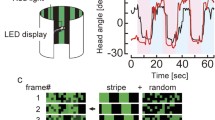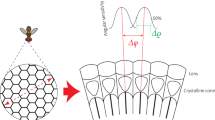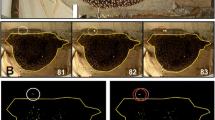Abstract
This paper investigates the problem of spontaneous pattern discrimination by the visual system of the fly. The indicator for discrimination and attractivity of a pattern is the yaw torque of a test fly. It is shown that the pattern discrimination process may be treated as a special (“degenerate”) case of figureground discrimination which has been described in detail in earlier publications. Decisive for the discrimination process is the fact that pattern discrimination by the fly is mediated by motion detectors which respond not only a pattern velocity but also to structural properties of pattern contrast. This is demonstrated by the transition from the existing twodimensional array of motion detectors to a continuous detector field which enabled us to calculate instantaneous detector responses to instationary pattern motion. The new approach, together with the special theory for figure-ground discrimination, is then applied to predict spontaneous discriminations of onedimensional periodic patterns. It is shown that predictions and experimental results are in good agreement. The second set of discrimination experiments deals with two dimensional dot patterns for which a quantitative theory is not yet available. However, it is shown that the attractivity of a dot pattern crucially depends on both the orientation and the direction of motion relative to the fly's eyes. If the contrast of a moving dot elicits an event in a motion detector which through the detector's time constant leads to an interference with an event received by a preceeding dot, the attractivity of the dot pattern is diminished. In the discussion relations are drawn between the concepts of pattern discrimination in honey bees and the theoretical aspects of discrimination put forward in this paper. It is briefly discussed why a two-dimensional motion detector theory might become the key for an understanding of pattern categories like “figural intensity” and “figural quality”.
Similar content being viewed by others
References
Barlow HB, Levick WR (1965) The mechanism of directionally selective units in rabbit's retina. J Physiol London 178:477–504
Buchner E (1984) Behavioral analysis of spatial vision in insects. In: Ali MA (ed) Photoreception and vision in invertebrates. Plenum Press, New York London, pp 561–621
Bülthoff H, Götz KG (1979) Analogous motion illusion in man and fly. Nature 278:636–638
Doorn AJ van, Koerderink JJ (1982a) Temporal properties of the visual detectability of moving spatial white noise. Exp Brain Res 35:179–188
Doorn AJ van, Koenderink JJ (1982b) Spatial properties of the visual detectability of moving spatial white noise. Exp Brain Res 45:189–195
Eckert H (1980) Functional properties of the H1-neurone in the third optic ganglion of the blowfly, Pheonicia. J Comp Physiol 135:29–39
Egelhaaf M (1985a) On the neuronal basis of figure-ground discrimination by relative motion in the visual system of the fly. I. Behavioural constraints imposed on neuronal network and the role of the optomotor system. Biol Cybern 52:123–140
Egelhaaf M (1985b) On the neuronal basis of figure-ground discrimination by relative motion in the visual system of the fly. II. Figure-detection cells, a new class of visual interneurons. Biol Cybern 52:195–209
Egelhaaf M (1985c) On the neuronal basis of figure-ground discrimination by relative motion in the visual system of the fly. III. Possible input circuitries and behavioural significance of the FD-cells. Biol Cybern 52:267–280
Fermi G, Reichardt W (1963) Optomotorische Reaktionen der Fliege Musca domestica. Kybernetik 2:15–28
Götz KG (1964) Optomotorische Untersuchung des visuellen Systems einiger Augenmutanten der Fruchtfliege Drosophila. Kybernetik 2:77–92
Götz KG (1968) Flight control in Drosophila by visual perception of motion. Kybernetik 4:199–208
Götz KG (1980) Visual guidance in Drosophila. In: Siddiqi O, Babu O, Hall L, Hall J (eds) Development and Neurobiology of Drosophila. Plenum Press, New York London Washington Boston, pp 391–407
Guo A, Reichardt W (1986) Figure-ground discrimination by relative movement in the visual system of the fly. Part III. Experiments and simulations of complex figure-ground situations with movement detectors input elements to the figure-ground circuit. Biol Cybern (in preparation)
Hassenstein B, Reichardt W (1956) Systemtheoretische Analyse der Zeit-, Reihenfolgen-und Vorzeichenauswertung bei der Bewegungsperzeption des Rüsselkäfers Chlorophanus. Z Naturforsch 11b:513–524
Hausen K (1981) Monokulare und binokulare Bewegungsauswertung in der Lobula plate der Fliege. Verh Dtsch Zool Ges 1981:49–70
Hausen K (1982) Motion sensitive interneurons in the optomotor system of the fly. Biol Cybern 46:67–79
Hausen K, Wehrhahn C (1983) Microsurgical lesion of horizontal cells changes optomotor yaw responses in the blowfly Calliphora erythrocephala. Proc R Soc Lond Ser B 219:211–216
Hengstenberg R (1982) Common visual properties of giant vertical cells in the lobula plate of the blowfly Callphora. J Comp Physiol 149:179–193
Hengstenberg R (1984) Roll-stabilization during flight of the blowfly's head and body by mechanical and visual cues. In: Varjú D, Schnitzler HU (eds) Localisation and orientation in biology and engineering. Springer, Berlin Heidelberg New York, pp 121–134
Hertz M (1929a) Die Organisation des optischen Feldes bei der Biene I. Z Vgl Physiol 8:693–748
Hertz M (1929b) Die Organisation des optischen Feldes bei der Biene II. Z Vgl Physiol 11:107–145
Kelly DH (1985) Visual processing of moving stimuli. J Opt Soc Am A2:216–224
Koch C, Poggio T, Torre V (1982) Retinal ganglion cells: a functional interpretation of dendritic morphology. Philos Trans R Soc London Ser B 298:227–264
Mastebroek HAK, Zaagman WH, Lenting BPM (1980) Movement detection: performance of a wide-field element in the visual system of the blowfly. Vision Res 20:467–474
McCann GD, MacGinitie GF (1965) Optomotor response studies in insect vision. Proc R Soc London Ser B 163:369–401
Poggio T, Reichardt W (1973) Considerations on models of movement detection. Kybernetik 12:223–227
Poggio T, Reichardt W (1976) Visual control of orientation behaviour in the fly. Part II. Towards the underlying neural interactions. Q Rev Biophys 9:377–438
Poggio T, Reichardt W, Hausen K (1981) A neuronal circuitry for relative movement discrimination by the visual system of the fly. Naturwissenschaften 68:443–446
Reichardt W (1957) Autokorrelations-Auswertung als Funktionsprinzip des Zentralnervensystems (bei der optischen Wahrnehmung eines Insektes). Z Naturforsch 12b:448–457
Reichardt W (1961) Autocorrelation a principle for evaluation of sensory information by the central nerous system. In: Rosenblith WA (ed) Principles of sensory communications. Wiley, New York, pp 303–317
Reichardt W (1973) Musterinduzierte Flugorientierung. Verhaltens-Versuche an der Fliege Musca domestica. Naturwissenschaften 60:122–138
Reichardt W, Egelhaaf M (1986) (in preparation)
Reichardt W, Poggio T (1979) Figure-ground discrimination by relative movement in the visual system of the fly. Part. I. Experimental results. Biol Cybern 35:81–100
Reichardt W, Varjú D (1959) Übertragungseigenschaften im Auswertesystem für das Bewegungssehen. Z Naturforsch 14b:674–689
Reichardt W, Poggio T, Hausen K (1983) Figure-ground discrimination by relative movement in the visual system of the fly. Part II. Towards the neural circuitry. Biol Cybern Suppl 46:1–30
Riehle A, Franceschini N (1984) Motion detection in flies: parametric control over ON-OFF pathways. Exp Brain Res 54:390–394
Santen JPH, Sperling G (1984) Temporal covariance model of human motion perception. J Opt Soc Am A1:451–473
Santen JPH, Sperling G (1985) Elaborated Reichardt detectors. J Opt Am A2:300–321
Schnetter B (1972) Experiments on pattern discrimination in honey bees. In: Wehner R (ed) Information processing in visual systems of arthropods. Springer, Berlin Heidelberg New York, pp 195–200
Torre V, Poggio T (1978) Synaptic mechanism possibly underlying directional selectivity to motion. Proc R Soc London Ser B 202:409–416
Wagner H (1985) Flight performance and visual control of flight of the free flying housefly (Musca domestica), I. Organization of the flight motor. II. Pursuit of targets. III. Interactions of wide field and target induced angular movement (submitted to Philos Trans R Soc London)
Wehner R (1981) Spatial vision in arthropods. In: Handbook of sensory physiology, vol VII/6c. Springer, Berlin Heidelberg New York, pp 287–616
Wehrhahn C (1985) Visual guidance during flight. In: Kerkut G, Gilbert L (eds) Comprehensive insect physiology, biochemistry, and pharmacology. Pergamon Press, Oxford, pp 673–683
Wehrhahn C, Reichardt W (1975) Visually induced height orientation of the fly Musca domestica. Biol Cybern 20:37–50
Wilson HR (1985) A model for direction selectivity in threshold motion perception. Biol Cybern 51:213–222
Wolf E (1934) Das Verhalten der Bienen genenüber flimmernden Feldern und bewegten Objekten. Z Vgl Physiol 20:151–161
Wolf E (1935) Der Einfluß von intermittierender Reìzung auf die optischen Reaktionen von Insekten. Naturwissenschaften 23:369–371
Wolf E, Zerrahn-Wolf G (1935) The effect of light intensity, area, and flicker frequency on the visual reaction of the honey bee. J Gen Physiol 18:853–863
Zerrahn G (1933) Formdressur und Formunterscheidung bei der Honigbiene. Z Vgl Physiol 20:117–150
Author information
Authors and Affiliations
Rights and permissions
About this article
Cite this article
Reichardt, W., Guo, Ak. Elementary pattern discrimination (behavioural experiments with the fly Musca domestica). Biol. Cybern. 53, 285–306 (1986). https://doi.org/10.1007/BF00336562
Received:
Issue Date:
DOI: https://doi.org/10.1007/BF00336562




